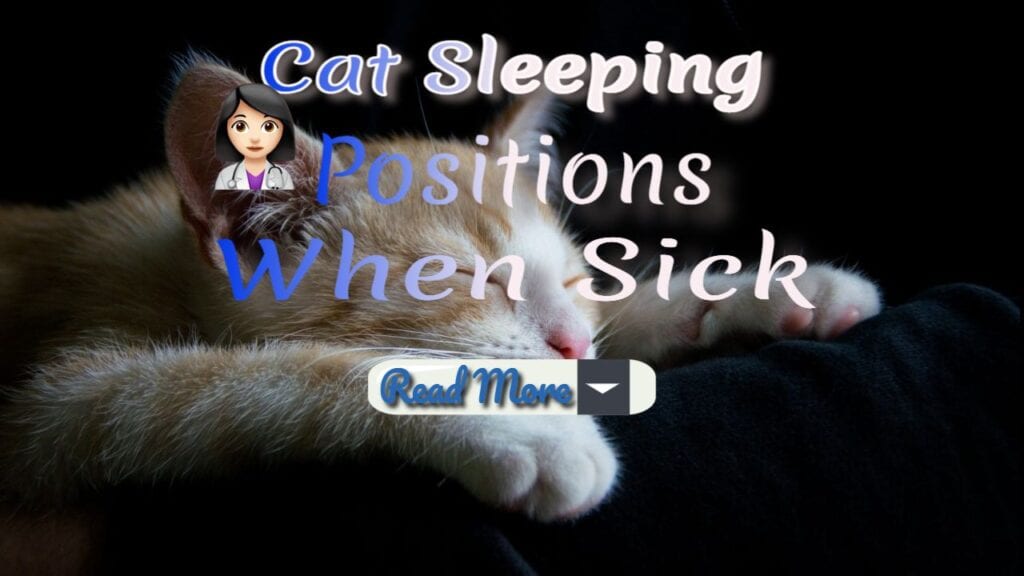On This Page
- Cat Sleeping Positions When Sick (and What They Mean!)
- What Do Different Cat Sleeping Positions Mean?
- Cat Sleeping in a Ball
- Cat Sleeping in Fetal Position
- Cat Sleeping Flat on Stomach
- Cat Sleeping Flat on Back
- Cat Sleeping Flat on Side
- Cat Sleeping with Another Cat
- Cat Sleeping with Eyes Open
- 10 Subtle Signs You Have a Sick Cat.
- Signs Your Cat is Sick or in Pain.
- Know the Ways of Cat Sleeping Position When Sick
- Examine the Sleeping Position of Your Cat
Cat Sleeping Positions When Sick (and What They Mean!)
That is obviously the most important thing. Comfort. We cat owners can do a lot to make our little feline friends comfortable when they are not feeling well or recuperating from an operation. When taking care of your sick cat, provide them with a very soft sleeping place. Preferable away from all the action. Just like humans, too much noise or action can disturb your cats recovery process or create undue stress, so find a quiet, comfortable place they won’t be disturbed in.
Lethargy is a common symptom of many different feline illnesses. While senior cats will naturally want to rest longer than a young adult cat, the sleeping position that a cat assumes could be a sign of sickness. Curling in a ball or adopting the fetal position suggests that your cat is struggling to stay warm. A cat on its side may be finding it hard to breathe or be attempting to relieve pressure on aching joints. Sleeping on the back can imply feelings of vulnerability, so the cat wants quick access to its claws for self-defence.
If your cat’s temperament changes unexpectedly, she is probably telling you something. A friendly cat may turn reclusive; a playful cat becomes apathetic; an elderly cat stops jumping into your lap or sleeping on your bed at night. By contrast, a laid back cat may be hyperactive, needy or meowy when he’s sick. Since cats are such great pretenders, a behaviour change may be your only clue that something is going on.
Taken alone, side-sleeping does not mean a cat is sick. Quite the opposite, in fact. It usually suggests a cat is happy and relaxed. Despite this, sick cats will often lie on their side. This resolves several ailments:
breathing is easier if a cat struggles for air
muscular pain is avoided as no pressure is placed on the joints
the exposure of soft skin regulates body temperature.
What Do Different Cat Sleeping Positions Mean?
Cats do not pant, breathe with an open mouth, or sleep with their mouths open unless there is something wrong. If your cat has been sleeping with their mouth open it may mean their respiratory system is struggling to cope or there is an issue with their circulation. It’s one of the more alarming sleeping positions, get them to a vet asap.
Apart from sleeping positions, some other common signs that a cat is sick, include.
I hope this article has helped you better understand a cat’s sleeping positions when sick, and some of the common signs to look out for that might indicate your cat is unwell. You know your cat better than anyone. If you notice a change in their behaviour, how they’re sleeping, or anything else that raises concern, you have to get them seen by a vet sooner rather than later.
Cat Sleeping in a Ball
Cats will rarely reveal that they are in physical discomfort. Unlike other animals, cats hide in dark places to avoid detection. In the mind of a cat, pain is a sign of weakness. This resting position is a means of relief. If your cat is sleeping curled in a tight ball and displays any of these physical traits, it is in pain.
Cats typically sleep curled up in a ball to keep some extra warmth in. It’s also a position that comes naturally to them and commonly seen in the wild. Sleeping in a ball in the wild offers protection for their vital organs if they’re attacked. It can also mean that your cat is in some discomfort as well, however. Last year, one of my cats had a serious bout of constipation. She actually started sleeping in a ball while it was painful when otherwise she usually a loafer.
If you notice your cat has started sleeping in a ball and it’s out of character for them, I’d give them a light physical to see if they’re in any obvious discomfort. Related content – why cats sleep curled up in a ball.
Cat Sleeping in Fetal Position
It is hard to diagnose illness by sleeping position alone. Cats sleep in a range of poses, many of which look very uncomfortable. Accompanied by physical symptoms of illness, a cat’s sleeping position can reveal what ails it. Table of contents:
also, look out for other changes in your cat’s sleeping routine. If your cat always slept alone but now looks for company, it may be feeling unwell. The cat is seeking comfort and protection while it dozes.
This pose helps a cat to retain body heat. Check the temperature of the cat and its surroundings while it is awake. If the cat has a safe temperature, consider whether it could be injured. The purpose of the fetal position may be to protect parts of the anatomy. In the fetal position, a cat cannot be touched on the paws or belly.
When your cat wakes up, check how well it moves. If the cat refuses to allow you to touch its paws, injury or discomfort is a possibility. This could be something minor, such as dry and cracked paw pads. If you find no obvious physical problem, it could be feeling vulnerable due to an illness. The fetal position helps a cat feel protected. The cat feels confident that it will not be disturbed as all delicate anatomy is protected.
Cat Sleeping Flat on Stomach
This is a sleeping position you need to pay attention to as what a cat does with their legs and head while on their stomach can signal different things. If they are in the loaf position (legs tucked in so they resemble a loaf of bread) this is a good sign. If they have their front legs stretched out, this is also a good sign.
If your cat is laying out flat on their stomach with their chin on the floor this is called the meatloaf position. It looks kind of cute sometimes, but this position can mean they are either perfectly fine or in some serious discomfort. Cats suffering from some kind of respiratory difficulties or lung issues will often assume this position. If you’re concerned, I suggest getting up close (without disturbing them) and watching and listening to how they’re breathing. If you see or hear anything that gives you concern get them checked out.
If you have a cat, you probably already know that we are particular in most of our preferences from food to sleeping positions. Personally, I love laying stretched out on my stomach, but i also switch it up a lot, too! there are many different types of sleeping positions from which your cat can choose. Some of them may not even be included on this list! cats are creative and curious so they may try to find new ways to keep comfortable. For the most part, there are a few signs to look for to make sure your cat is feeling their very best.
Cat Sleeping Flat on Back
If you are still wondering about the cat sleeping position when sick. One way to guess their health is to check that if they are sleeping flat on their sides. You must know the fact that the side sleeping position of your cat does not mean that it is sick. This posture usually suggests that they are happy and have filled up their stomach and wants a peaceful sleep. There are many reasons for cats to follow such sleeping habits, the common one is –.
The petfusion ultimate cat scratcher lounge is $30 cheaper and five inches shorter than our cardboard lounger pick, the petfusion jumbo cat scratcher lounge. This one is just as durable as our pick, but it fell short of our recommendation because it has deep curves that are uncomfortable for some cats to sleep on. It also lacks valuable sleeping space on the bottom tier, so it’s not ideal for multicat households. The jumbo has a flatter shape so cats can use either the top or bottom level.
Cat Sleeping Flat on Side
One of the most common feline health problems inside your cat, tapeworms live in kitty’s small intestine and sometimes grow as long as 2 feet. That said, tapeworms are segmented and usually break apart when expelled. It’s very unlikely to see a full worm. You will usually see the segments. Symptoms of a tapeworm infection can be subtle but may include vomiting and weight loss. The easiest way to tell if your cat has tapeworms is to look at its faeces, around its anus and in bedding. Usually, tapeworms come out of your cat’s anus while it is sleeping or relaxed.
Many cats will not sleep in this position if sick or unwell. This is primarily because sleeping on the side leaves a cat exposed. As established, sick cats feel vulnerable. This means the cat will avoid a defenceless pose. Look out for the following behaviours while your cat is awake, though:
limping
refusing to run, jump, or climb
trouble climbing in or out of litter tray.
If your cat is sleeping on their side, it’s not likely they are sick or in any discomfort. This is the go-to sleeping position for cats that are happy and healthy. By exposing their tummies they are letting you know that they feel safe and secure. It can take a while for a cat to let their guard down like this, so take it as a positive sign.
Almost all of us cats love our sleeping time. If your cat is sleeping all day long, this is not necessarily a sign of any problems. Like I mentioned earlier, it’s important to consider your cat’s specific habits when analyzing their sleeping positions. If your cat plays most of their day and all of a sudden starts sleeping more often, this might hint at something being wrong. The reason why cats love sleeping so much is an instinctive tendency coming from the wild. When cats are in the wild, they sleep to conserve their energy.
Cat Sleeping with Another Cat
Cats often sleep alone, even if they share a home. This is due to the territorial nature of cats. A bed, or favoured hiding spot, will be claimed by a rival feline. Exceptions to this rule may include siblings or cats that grew up together. These cats will forge a bond that is not broken in adulthood. Co-sleeping is relatively common, though.
Symptoms of a tapeworm infection can be subtle but may include vomiting and weight loss. The easiest way to tell if your cat has tapeworms is to look at its faeces, around its anus and in bedding. Usually, tapeworms come out of your cat’s anus while it is sleeping or relaxed. If you see small white worms or what look like grains of rice or sesame seeds, your cat likely has tapeworms.
Cats are known for sleeping the day away, but it is possible for a cat to sleep too much! cats sleep an average of 12-16 hours each day, and more if they’re elderly. If you notice your cat sleeping more than usual, being disinterested in food or toys, and not reacting like normal to certain things – he is lethargic.
If your cat starts sleeping with a fellow cat, watch its behaviour while awake. Co-sleeping suggests that the cat is unwell. It is asking another cat to watch over it while dozing. A cat will only do this if very unwell. The cat understands that it will relinquish all dominant status by asking another cat for help. In most instances, the cat would prefer to sleep with an owner.
Cat Sleeping with Eyes Open
The fp virus causes damage to the cells that line the intestines. It also attacks the bone marrow and lymph nodes, resulting in shortages of all types of white blood cells (panleukopenia) and of red blood cells (anaemia). The first visible signs an owner might notice include generalized depression, loss of appetite, high fever, lethargy, vomiting, severe diarrhoea, nasal discharge, and dehydration. Sick cats may sit for long periods of time in front of their water bowls but not drink much water. In some cats, the fever will come and go during the illness and abruptly fall to lower-than-normal levels shortly before death.
A sick cat may also sleep with one or both eyes open. This suggests that the cat feels vulnerable. It is unwilling to fall into a deep sleep in case it needs to react to changing circumstances.
Cats appearing to sleep with one eye open is a common occurrence. Your cat is genuinely sleeping. Cats have a transparent third eyelid (nictating membrane) which closes. The purpose of this is so a cat can stay
alert. The cat’s peripheral vision will still capture potential threats. Equally, the cat can react faster upon waking up. The cat was not in a deep.
Sleep and will thus not be groggy. Sick cats often sleep with the eyes open. Cats with urinary infections will want to make a rapid trip to the litter box. Cats that struggle for breath will be concerned about falling asleep too deeply. Keeping the eyes open ensures the sleep never gets further than a light nap. If your cat adopts a variety of sleeping positions, it’s likely to be fine. One sleeping position at all times can suggest that a cat is sick.
10 Subtle Signs You Have a Sick Cat.
Cats are sentient, living beings that will get sick or injured at some point as they tick off their nine lives, just like we do. However, there is no nhs for our feline friends. It is all private and private health care costs money. Some typical costs of treatment are set out below:
teeth problems are the most common disease of adult cats. Studies have found signs of dental disease in up to 70% of cats over 5 years of age. This is a problem you are almost certainly going to encounter with your cat at some point despite what you feed.
As every pet owner knows it can be hard to tell when your pet gets sick. And as a cat sitter, it can be even harder to detect if you are caring for a sick cat. However, there are clues, clear signs you can look out for to detect some classic ailments. In this blog, we focus on cats and looking ours for classic symptoms of feline ailments. If you think you have a sick cat, read on….
It’s the dread of any cat owner – thinking or finding out that our cats are sick. We love our little balls of fluff, and i’m sure you’ll agree it’s quite distressing when they’re ill because it’s so hard to read how much pain they’re in. It’s often up to us to pick up on little signs and bits of body language when they’re sick. As well as finding them the best course of treatment as soon as possible.
Weight loss and associated cat disease may be subtle due to the abundant coat, especially if she is not particularly fond of sitting on her hands or is entirely independent in contact with the owner. How to understand if a cat is sick in this case? it recommends that you regularly conduct a simple home examination of domestic cats, literally from the tip of the nose to the tail’s tip. In this case, it is worth evaluating the cleanliness and clarity of the eyes and nostrils, the coat’s condition, and claws.
Signs Your Cat is Sick or in Pain.
An attentive owner will pay attention to the changed behaviour of the pet. If the cat is hiding or continually trying to climb onto its knees, it is a reason to take a closer look at the animal. In pain and always affectionate, the cat can suddenly turn into a vicious fury and become aggressive. How to determine that a cat is sick, focusing on his behaviour and appearance? the symptoms of trouble are as follows.
A cat in the loaf position is usually planning a brief nap. The cat tucks its paws and tail to keep warm. The cat will keep its head upright to remain alert. If sleep claims the cat, the head will eventually drop. This is referred to as a “collapsed loaf. ”sick cats will rarely adopt the loaf position. If the cat has serious concerns about body temperature, it will curl up for warmth. If it is a pain, it will avoid remaining quite so conspicuous.
According to vetstreet, cats will often lie quietly in a hunched position when they are sick. This is probably the most understandable position to us, we also hunch over in pain when were sick. If your cat is clearly hunched over, I’d call your vet and ask their advice at the very least. Look for other signs that they aren’t well too, such as not drinking, eating, or grooming properly.
The most common sign of illness in some cats is hiding in a quiet, out-of-the-way place. Sick cats often lie quietly in a hunched position. They might neglect to groom. They may be purring, which cats do not only when they’re happy, but also when they’re sick or in pain. A cat with breathing difficulties may refuse to lie on his side and may keep his head raised. Cats with neurological problems may be confused, have seizures or press their heads into furniture or walls. This is not the head butting that cats do on your leg affectionately but rather prolonged pressing on a surface.
Know the Ways of Cat Sleeping Position When Sick
What can you tell from cat sleeping positions when they’re sick? you can tell a lot from a cat’s body language, especially how they choose to sleep. Cats instinctively hide illness from us, so it’s up to use to decode their behaviour.
The “cat loaf” is one of my personal favourite positions! the reason why our cats love this position so much is it allows us to be comfortable, but also ready to make quick movements if needed. Also, we just look so adorable! my human, jeff, says I’m his favourite kind of loaf. When you are a pet parent of any kind, it’s important to understand and observe your pet’s habits on a daily basis. If they start making significant changes to their routine, they may be hinting that something is wrong with their health.
When you are a pet parent of any kind, it’s important to understand and observe your pet’s habits on a daily basis. If they start making significant changes to their routine, they may be hinting that something is wrong with their health. Sadly, we cannot speak human language and our meows tend to be difficult to understand. So we have to show our pet parents that something is wrong in other ways. One of the ways we do this is the positions in which we are sleeping. Us cats are very strong creatures, and will often try to hide any sort of illness or pain we are having.
Examine the Sleeping Position of Your Cat
If you notice your furry friend sleeping on their back, this is a great sign! this usually means they are comfortable with you. Cats are very particular in terms of where they will accept rubs and scratches. Some cats love belly rubs and others despise them. Regardless, if your cat is exposing their cute little tummy, they trust you and feel safe with you. When cats lay in this position, they are usually not on alert or concerned about their surroundings.
If your cat sleeps or cuddles with you – you are in luck! this means they love you very much. But don’t worry! even if your furry friend does not cuddle with you, they still do love you. But this is an exciting sign that your cat feels comfortable enough with you to put their defences down while asleep. Cats are not usually known for being “extra” cuddly. But each one of us is unique and special! this sleeping position might also mean that your cat needs a little extra love and attention.
People also asked Google
What to give cats when they are sick
What are the symptoms of a cat dying
Do cats sleep more when sick
How do cats sleep when they’re sick
How do you comfort a sick cat
How does my cat know when I’m sick
Is it time to put my cat to sleep
What is the average lifespan of a house cat
What are the symptoms of a cat dying of kidney failure
Do cats stop purring when they are dying
Where do cat go when they die
At what age do cats usually die
Should I leave my cat alone when sick
How do you keep a sick cat hydrated?
What home remedy that helps cats from throwing up
Why do cats walk on you while you sleep
Do cats know when you’re on your period
Do cats know when you cry
Can you use Vicks on cats
Will a cat eat if it’s sick
The post Cat Sleeping Positions When Sick appeared first on Catnip Utopia.
The post Cat Sleeping Positions When Sick appeared first on Our Animal Friends.
The post Cat Sleeping Positions When Sick appeared first on GQ Central.




